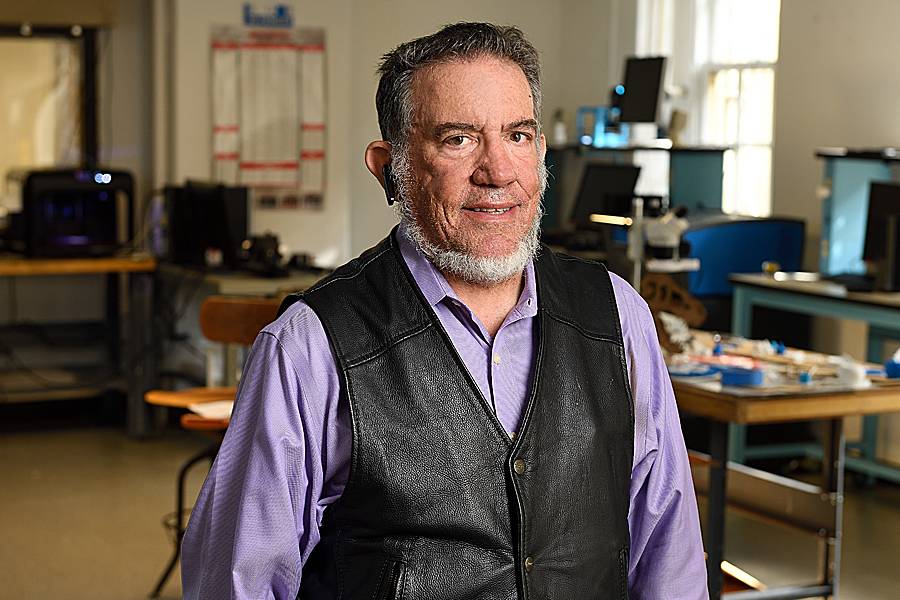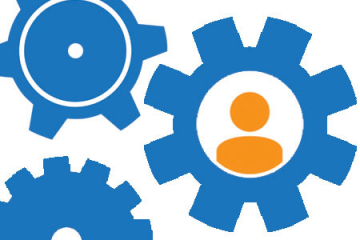When you're tasked with ensuring that lasers are used safely on a university campus, there's one theme that underpins everything: "Safe science is good science." It's the mantra of Johns Hopkins' Laboratory Safety Advocate's Office and a guiding principle for Niel Leon in his daily efforts to make sure that Homewood's many and varied lasers are employed in the safest manner possible. Safety is also job one in Leon's other responsibilities—from supervising the use of drones on campus to seeing that machinery is used responsibly and by those who are properly trained. We sat down recently to talk safety with Leon, who is Homewood's laser safety advocate and the senior manufacturing engineer for the Whiting School of Engineering Design Services and Advanced Manufacturing Laboratory.
How prevalent are lasers on campus, and what are they being used for?
We now have over 270 registered lasers on the Homewood campus, with wavelengths from 265nm to over 10,600nm and powers up to 1kW. They're used everywhere—from doing machining and processing, to doing research for Mechanical Engineering, Materials Science and Engineering, Electrical and Computer Engineering, Chemical and Biomolecular Engineering, Chemistry, Physics, Astrophysics, and Biology.
The Mind/Brain Institute uses lasers to stimulate or inhibit signals in the brain, and the Hopkins Extreme Materials Institute uses a pulsed laser to do micromachining. Our most powerful laser is being used for a joint project with the Chemistry and Physics departments.
We also have a number of laser cutters in WSE Manufacturing that can be used by any student, staff, or faculty for either a university or an independent nonsponsored project. All you need is a JHED ID.
And what does the laser safety advocate do?
My purpose as the laser safety advocate is to assist researchers with the design and implementation of experimental systems that are easier and safer to operate. These experiments will be more reproducible and defendable in the peer review literature, and, when all is said and done, the research will be performed much more safely.
This is an important philosophical element of how I work: We're trying to control a researcher's experiment to make sure it's reproducible. By doing this, safety becomes an inherent result not an implicit requirement.
And by selecting the proper laser system upfront, or by designing and implementing optimal engineering controls to an experiment being developed, we can often create a safer laser experiment for little or no additional cost, or even save money. For one student laboratory experiment, by adding a $25 piece of equipment we were able to save the university more than $10,000 in special laser safety glasses and laser protective curtains.
You're also involved in making sure drones are used safely on campus, right?
Yes, I've gotten involved in working with UAVs [unmanned aerial vehicles], more commonly known as drones. I am currently working with the university administration to establish a policy and protocols for how UAVs are to be used on the Homewood campus to make sure all flights are in accordance with FAA [Federal Aviation Administration] regulations and best practices.
Are there often drones flying overhead?
I currently get between one and two requests for flights per month, but I expect that to pick up as more and more research efforts get involved in this field. The most active groups are Computer Science, Electrical and Computer Engineering, and the LCSR [Laboratory for Computational Sensing and Robotics].
Anyone flying over campus in national air space must follow FAA Part 107, the law that governs flying small UAVs. That means the pilot in command needs to have a remote pilot's certificate—I have one—and that the pilot has to follow specific flight rules, including distance from people on the ground and the time of day you're allowed to fly.
As part of our preflight process, we file a Notice to Airmen with the FAA—that lets other pilots in the area know a UAV is being flown nearby. This is particularly important since we're in the shadow of a helipad, with Union Memorial Hospital being three blocks away. We want to make sure the medevac pilots know we have a bird in the air and that the pilot is properly aware of the critical nature of their flight.
You have a few other hats that you wear professionally, right?
Yes, one my roles is working to develop a more robust capital equipment tracking process. Basically, when the university buys a piece of capital equipment, they need to know where it is, who can use it, what it's being used for, and is there a possibility of somebody [else] using it? We also need to be able to ensure that all the people that are going to be using that equipment get the appropriate training to be able to use it safely. Then, at the end of life, when it's no longer being used, how do we dispose of it properly, and can we recover some money during the disposal process?
Another role I have is to design products and devices for researchers or other people within the university who need them. So I've worked with the Alumni Association, for example, to redesign the Bronze Johns. [Editor's note: These are small busts of Johns Hopkins given each year to distinguished alumni and friends of the university. You can read more about the redesign here].
What is your average day like?
There is no average day. But part of every day is walking to and from home. I live just across the street from Union Memorial Hospital, and I try to go home for lunch at least four days a week so that I average 6.5 miles a day, walking. I can be in my office for a long time, trying to develop things, or working in CAD [computer-aided design] programs to design items. Or I can be using the makerspace to do assembly and fabrication, or using the machine shops or 3-D printers. I also have to go in and review lab setups as part of my safety advocacy. So I may be all over campus, even including the Space Telescope [Science Institute]—they have lasers there. In fact, they were the first site that I set up an installation for on this campus.
Is there a project you've done that ranks among your favorites?
I was working with an outside organization called V-LINC, whose volunteers [use] medical engineering [to craft assistive technology solutions for people with disabilities]. And working with the ASME student chapter, we produced a number of projects to assist children with disabilities. One was a scooter for a little boy with cerebral palsy; another was a walker for a little girl who at 2 years old only weighed 11 pounds. Those are projects that I'm particularly proud of. But there are many exciting and challenging projects. And every project is different, every one is unique in that you have different challenges, different critical aspects that you have to be able to address. The project I like the best is the one I'm working on.
Is there any part of your job that might surprise people to know?
It often surprises people that safer research is better research. The things you do to assure safety—take a careful look at what you're doing, assess possible outcomes, plan for contingencies—are the same things you do to assure quality research. Sometimes people get the idea that safety is an impediment to their research, usually when they view it as an add-on instead of an add-in. We do safety together with the researchers—it's a "we" process, not a "you" process plus an "I" process.
Posted in News+Info
Tagged who does that?









